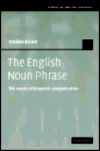 The English Noun Phrase: an empirical study
The English Noun Phrase: an empirical study
funded by
![]()
Research monograph published by Cambridge University Press
Keizer, E. (2007). The English Noun Phrase: The Nature of Linguistic Categorization, Studies in English Language (series). Cambridge: CUP. More...
Project Proposal
Research Imperative & Context
Nouns are of pivotal importance in languages like English. It has been observed that along with verbs they are a dominant part of speech, and that the semantic content of sentences is borne mostly by nouns (Algeo 1995: 203). The importance of the Noun Phrase in language was acknowledged by the European Science Foundation, when it made this topic one of the central themes of its Eurotyp Project (Programme in Language Typology, 1990-4; Siewierska 1997). However, Eurotyp was concerned with universals in the languages of Europe, and not specifically with the typology of English. Theoretical, typological, as well as descriptive research on English Noun Phrases has tended to concentrate on specific, isolated aspects of their internal structure. This work is very valuable, but it is noteworthy that no study has yet been carried out which comprehensively considers the structural, functional and textual dimensions of NPs, with an emphasis on the interrelationships between these dimensions. Many fundamental issues in NP structure and distribution therefore remain unresolved. Some of these are listed in the next section.
Aims & Objectives
The project's aims are to carry out a large-scale study of the English Noun Phrase (NP), using the recently completed British component of the International Corpus of English (ICE-GB) as a database. ICE-GB is a fully tagged and parsed one-million word corpus (see below under Methodology). The overall research objective will be to produce a comprehensive typology of English NPs which will be published in a monograph, and in a searchable form on the project website.
Research Issues
In order to achieve this objective, the following research issues will be addressed, amongst others.
Structural
- Headedness in NPs (cf. Zwicky 1985; Hudson 1987, 1990; Coppen 1992; Radford 1993; Abney 1986; Aarts 1998): often this is an uncontroversial issue, but how can various syntactically peculiar structures such as e.g. these sort of problems, where there is a mismatch between the number of the determiner these and that of the following noun, be accounted for?
- 'Heaviness': this notion is clearly related to the number of elements an NP contains, but the question arises whether any other relationships obtain, e.g. between heaviness and information content (cf. Aarts 1992: 83f.).
- The possible interdependence between the different types of determination and modification in NPs.
- The distinction and relationship between postmodification, complementation and apposition in NPs (de Haan 1989, Mackenzie 1997, Fries 1999).
- The relationship between NP types and their distribution in clause structure (cf. Aarts 1971).
- The syntactic description of the English determiner system (Abney 1987).
Functional
- The variation in the kind of grammatical functions that NPs realise, and the explanations for the observed patterns.
- What relationships can be observed between grammatical function and NP complexity?
Textual
- The distribution of NP types in different textual categories.
- NP complexity: does it vary significantly between speech and writing, and do the two modes exhibit internal variation?
- The relationship between NP complexity, function and text type.
Methodology
Because of the frequency and variety of NPs, the study would be impossible without access to a large corpus of naturally-occurring NPs. The Survey of English Usage has recently completed such a corpus, the ICE-GB corpus of British English. This contains just over 1 million words (83,000 sentences) of spoken and written English. Each sentence has been parsed at the function and category levels, and the analyses are represented in the form of labelled syntactic trees (for more information on ICE-GB click here). The corpus contains c.313,000 NPs, or 4.4 per sentence. Each sample in the corpus is further coded for text type and source. As well as compiling the corpus, the SEU has also devised a methodology for exploring it (Aarts, Nelson, Wallis, 1998; Nelson et al. 2000), called Fuzzy Tree Fragments (FTFs). FTFs allow users to construct templates of structures or partial structures which the dedicated retrieval software, ICECUP (the International Corpus of English Corpus Utility Program), matches against similar structures in the corpus. The method is fast and flexible, and above all it allows for a cyclical exploration of the data. At every point, users can refine search templates in response to insights gained from previous exploration phases. Using FTFs, researchers can specify as little or as much detail as is required. In the case of Noun Phrases, not only can the NP structures themselves be specified, but also the surrounding structures. So NPs in specified contexts can be retrieved, e.g. NPs embedded in other phrases, or NPs in specific clause types. Finally, ICECUP allows users to define subcorpora, enabling the study of NP complexity across the full range of text types. A central element of the proposed research programme will be a website dedicated to the syntax of English Noun Phrases. This will be launched at an early stage in the project, and will be housed on the UCL server. The website will minimally contain the following elements:
- Downloadable FTFs, so that our corpus exploration methodology can be independently verified.
- A comprehensive description of the project, together with interim and final results in the form of downloadable papers.
- A searchable typology of English Noun Phrases, which will develop in parallel with the ongoing research.
- A bibliography, which will be regularly updated throughout the lifetime of the project.
It is anticipated that the English Noun Phrase Website will develop into a rich resource for linguists, language engineers, and students working in this field. It will complement the existing Eurotyp Noun Phrase Universals Archive, which was established by the Eurotyp Working Group on Noun Phrases.
References
Aarts, B. (1992) Small Clauses in English: the nonverbal types. Berlin and New York: Mouton de Gruyter.
Aarts, B. & C. F. Meyer (eds.) (1995) The verb in contemporary English: theory and description. Cambridge: Cambridge University Press.
Aarts, B. (1998) English Binominal Noun Phrases. Transactions of the Philological Society 96. 117-158.
Aarts, B, G. Nelson & S. Wallis (1998) Using Fuzzy Tree Fragments to Explore English Grammar. English Today 55. 52-56.
Aarts, F. (1971) On the distribution of Noun Phrase types in English clause structure. Lingua 26. 281-293.
Abney, S. (1986) The English Noun Phrase in its sentential aspect, PhD, MIT.
Algeo, J. (1995) Having a look at the expanded predicate. In B. Aarts and C. Meyer (1995) The verb in contemporary English: theory and description. Cambridge: Cambridge University Press. 203-217.
Coppen, A. (1992). Specifying the Noun Phrase. Computational Linguistics 18. 115.
Fries, P. (1999) Post nominal modifiers in the English noun phrase. In P. Collins and D. Lee (1999) (eds) The Clause in English. Amsterdam: John Benjamins. 93-110.
Haan, P. de (1989) Postmodifying clauses in the English Noun Phrase: a corpus-based study, Amsterdam: Rodopi.
Hudson, R. (1987) Zwicky on Heads. Journal of Linguistics 23. 109-132.
Hudson, R. (1990) English Word Grammar. Oxford: Blackwell.
Hudson, R. (1997) Syntax without functional categories. UCL Working Papers in Linguistics 9. 253-279.
Mackenzie, L. (1997) Grammar, discourse, and knowledge: the use of such in written English. In Aarts, J, I. de Mönninck and H. Wekker (eds) Studies in English Language and Teaching. Amsterdam: Rodopi.
Radford, A. (1993) Head-hunting: on the trail of the nominal Janus. In Corbett, G. G., N. M. Fraser and S. McGlashan (eds) Heads in grammatical theory. Cambridge: Cambridge University Press. 73-113.
Siewierska, A. (ed.) (1997) Constituent Order in the Languages of Europe: Eurotyp 20-1. Berlin: New York: Mouton de Gruyter.
Zwicky, A.M. (1985) Heads. Journal of Linguistics 21. 1-29.
Downloads
Documents (PDFs)
Chapter 4: Close appositions (634Kb)
Bibliography (180Kb)
Final report (web page)
Fuzzy Tree Fragments
The following represent a small number of FTFs and matching examples. The highlighted nodes in the examples correspond to the nodes in the previous FTF.
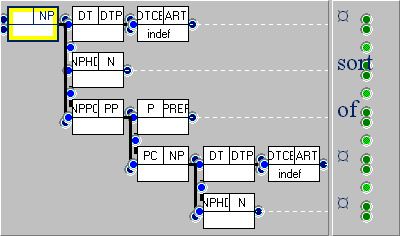 FTF 1: sort of a construction |
||
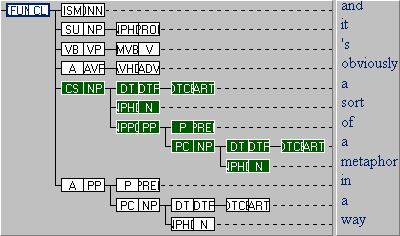 Example 1.1: a sort of a metaphor (S2A-049 003) |
||
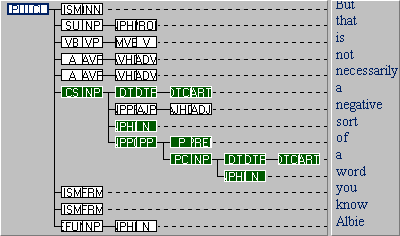 Example 1.2: a negative sort of a word (S1A-091 084) |
||
| |
||
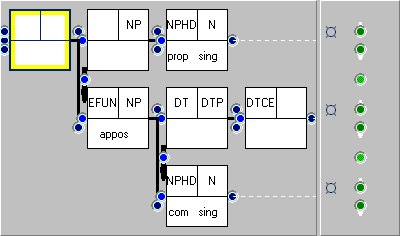 FTF 2: Close apposition Type 1a: 'name + the + noun' |
||
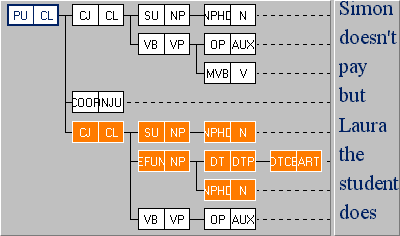 Example 2.1: Laura the student (S1A-007 231) |
||
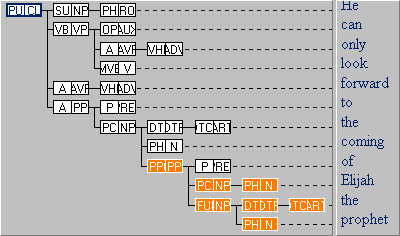 Example 2.2: Elijah the prophet (S2A-036 138) |
||
| |
||
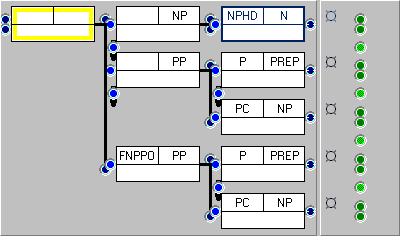 FTF 3: PP extraposition |
||
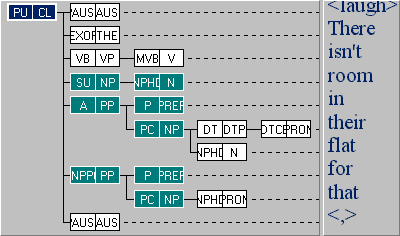 Example 3.1: room in their flat for that (S1A-017 141) |
||
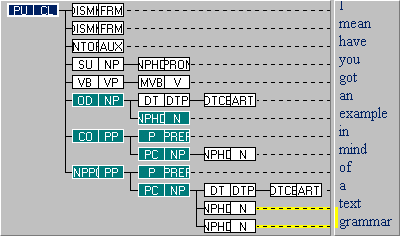 Example 3.2: an example in mind of a text grammar (S1A-024 099) |
||
This page last modified 14 May, 2020 by Survey Web Administrator.
